 This is a rewrite of a post from last year about the Zenitar 16mm fisheye lens, and fisheye lenses in general. Since then I have bought a full-frame camera, and I have assembled a mass of images, and the original post was looking a bit old-fashioned. Но́вая метла по-но́вому метёт, as they say in Russia.
This is a rewrite of a post from last year about the Zenitar 16mm fisheye lens, and fisheye lenses in general. Since then I have bought a full-frame camera, and I have assembled a mass of images, and the original post was looking a bit old-fashioned. Но́вая метла по-но́вому метёт, as they say in Russia."За державу обидно"
 The Zenitar 16mm f/2.8 is a fisheye lens from the Russian Federation. It is or was manufactured by KMZ of Krasnogorsk, which is just north-west of Moscow, and as far as I can tell the only way to buy the lens in the UK is via eBay. It typically costs around £130.
The Zenitar 16mm f/2.8 is a fisheye lens from the Russian Federation. It is or was manufactured by KMZ of Krasnogorsk, which is just north-west of Moscow, and as far as I can tell the only way to buy the lens in the UK is via eBay. It typically costs around £130. I bought one a year ago, and measured in terms of entertainment versus cost it has been the most entertaining £130 I have ever spent on a single object. KMZ still lists it on their website, although I have the impression that the company made thousands during the Communist era and are just selling off old new stock. Here's what it looks like:
I bought one a year ago, and measured in terms of entertainment versus cost it has been the most entertaining £130 I have ever spent on a single object. KMZ still lists it on their website, although I have the impression that the company made thousands during the Communist era and are just selling off old new stock. Here's what it looks like: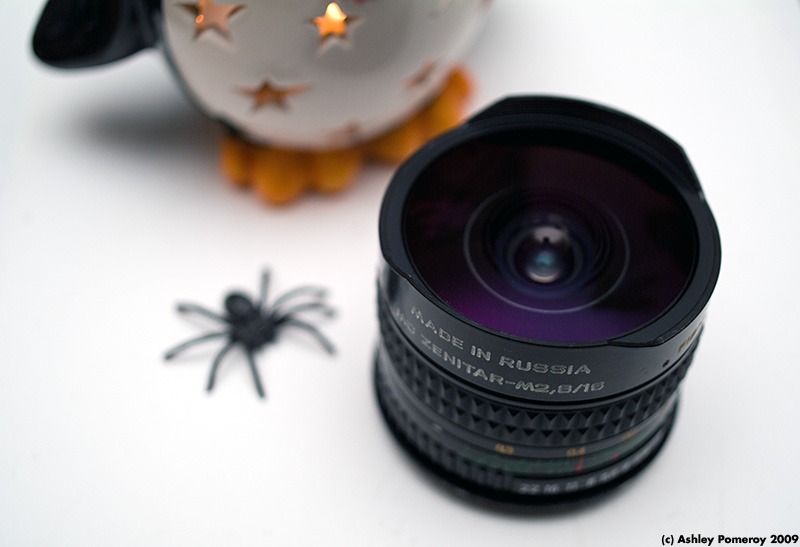 In the picture a giant flaming penguin has sent a little scout - I call her Salotine MacClacky - to inspect the strange metal object that has disturbed the snow-white snow of penguin land. The Zenitar is multi-coated, which is just as well because its unshielded front element would flare like mad otherwise and there is no practical way to mount a lens hood onto a fisheye lens. It still flares when light sources are near the edge of the frame, but it's not an insurmountable problem. Compared to my modern Sigma 15-30mm it is a delight. Here's an example of the Zenitar's handling of lights in the corner of the image:
In the picture a giant flaming penguin has sent a little scout - I call her Salotine MacClacky - to inspect the strange metal object that has disturbed the snow-white snow of penguin land. The Zenitar is multi-coated, which is just as well because its unshielded front element would flare like mad otherwise and there is no practical way to mount a lens hood onto a fisheye lens. It still flares when light sources are near the edge of the frame, but it's not an insurmountable problem. Compared to my modern Sigma 15-30mm it is a delight. Here's an example of the Zenitar's handling of lights in the corner of the image: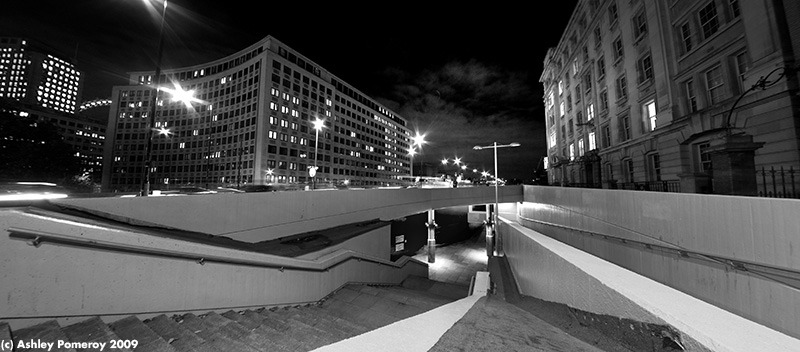 Almost all of the images on this page have been corrected with software so that there is very little perspective distortion. Fisheye lenses were originally developed as a means for astronomers and meteorologists to photograph the entire sky from horizon to horizon. There's a good article about the use of fisheye lenses in an astronomical context here, and this page has an example of a modern device that will automatically photograph the sky during inclement weather conditions. Fisheye lenses were brought into a traditional 35mm photographic context by Nikon, back in the early 1960s, with an 8mm lens that is nowadays a rare and valuable antique. Here's an example of the traditional fisheye look:
Almost all of the images on this page have been corrected with software so that there is very little perspective distortion. Fisheye lenses were originally developed as a means for astronomers and meteorologists to photograph the entire sky from horizon to horizon. There's a good article about the use of fisheye lenses in an astronomical context here, and this page has an example of a modern device that will automatically photograph the sky during inclement weather conditions. Fisheye lenses were brought into a traditional 35mm photographic context by Nikon, back in the early 1960s, with an 8mm lens that is nowadays a rare and valuable antique. Here's an example of the traditional fisheye look: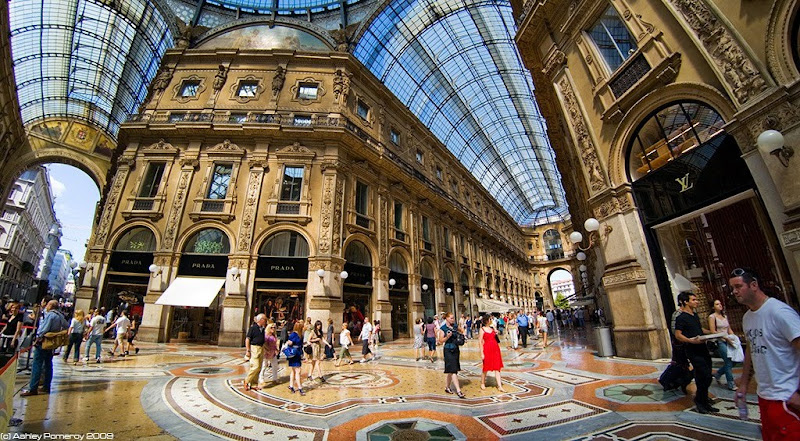 Damn that would have been a better picture if I'd pressed the button a few seconds earlier. The lady in the red dress would be closer to the middle of the frame and the stupid-looking Wayne Rooney sunglasses-wearing idiot in the shorts would not exist. Here's some boats:
Damn that would have been a better picture if I'd pressed the button a few seconds earlier. The lady in the red dress would be closer to the middle of the frame and the stupid-looking Wayne Rooney sunglasses-wearing idiot in the shorts would not exist. Here's some boats: The look quickly became a cliché of the 1960s psychedelic rock music movement, and a certain kind of modernist photojournalism, and then it died a death, rather like Trevor Horn's orchestra hits in Owner of a Lonely Heart or the stuttering effect in Paul Hardcastle's Nineteen. Modern computing technology and digital imaging have breathed some life back into the fisheye look, because it is now possible to use special secret magic to turn fisheye images into extremely wide panoramas that would be impossible to produce with a single exposure otherwise.
The look quickly became a cliché of the 1960s psychedelic rock music movement, and a certain kind of modernist photojournalism, and then it died a death, rather like Trevor Horn's orchestra hits in Owner of a Lonely Heart or the stuttering effect in Paul Hardcastle's Nineteen. Modern computing technology and digital imaging have breathed some life back into the fisheye look, because it is now possible to use special secret magic to turn fisheye images into extremely wide panoramas that would be impossible to produce with a single exposure otherwise. Most modern lens manufacturers make at least one fisheye. Canon sells a 15mm model for just under £600. Nikon's 16mm equivalent is roughly the same price, and I surmise that there is a very small but steady market for such lenses, because some people need the effect for their work. Or perhaps there are some people who have every other lens that the manufacturer makes, and they want to complete their collection. £600 is a lot of money for a toy you will never use, and thankfully there are cheaper options in a variety of focal lengths.
Most modern lens manufacturers make at least one fisheye. Canon sells a 15mm model for just under £600. Nikon's 16mm equivalent is roughly the same price, and I surmise that there is a very small but steady market for such lenses, because some people need the effect for their work. Or perhaps there are some people who have every other lens that the manufacturer makes, and they want to complete their collection. £600 is a lot of money for a toy you will never use, and thankfully there are cheaper options in a variety of focal lengths. The choice of focal length will depend on your camera. You probably have a full-frame camera, in which case something in the 15-18mm range will fill the viewfinder with scenery, whereas an 8-10mm fisheye will produce a circular image in the centre of the frame, like so. Your wife or daughter might have a small-sensor digital SLR, in which case an 8-10mm fisheye will fill the frame, and a 15-18mm fisheye will produce an image that is moderately wide and moderately distorted and generally unimpressive.
The choice of focal length will depend on your camera. You probably have a full-frame camera, in which case something in the 15-18mm range will fill the viewfinder with scenery, whereas an 8-10mm fisheye will produce a circular image in the centre of the frame, like so. Your wife or daughter might have a small-sensor digital SLR, in which case an 8-10mm fisheye will fill the frame, and a 15-18mm fisheye will produce an image that is moderately wide and moderately distorted and generally unimpressive. Look at the little people. They are like ants. Ants without a purpose. Who can corral them? A mass of ants, working together, could strip a human city of all organic matter and turn it into a clean concrete tomb. Imagine what human beings could do, if they were of like mind. We could cleanse this earth of organic filth and turn it into a beautiful chrome orb.
Look at the little people. They are like ants. Ants without a purpose. Who can corral them? A mass of ants, working together, could strip a human city of all organic matter and turn it into a clean concrete tomb. Imagine what human beings could do, if they were of like mind. We could cleanse this earth of organic filth and turn it into a beautiful chrome orb.I digress. Until a few years ago your choices for cheap fisheye lenses were limited to the 8mm Peleng and the 16mm Zenitar, plus a bunch of fisheye adapters that sit on top of normal lenses. Nowadays a company called Samyang sells a new 8mm fisheye designed specifically for crop-sensor cameras. There are also second-hand fisheye lenses from the 1970s, such as the tiny 16mm Olympus f/3.5 and the 17mm Pentax Takumar f/4. These sell for around £400 depending on condition, although they tend to have been well-kept, because they were esoteric and expensive lenses when new.
 At £130 the Zenitar is therefore a bargain, but it has one major problem, which is that the build quality is poor. Or rather, quality control is poor. The lens is made of metal, and my copy feels tough, but it did not leave the factory in a finished state. After I got my lens through the post I had to:
At £130 the Zenitar is therefore a bargain, but it has one major problem, which is that the build quality is poor. Or rather, quality control is poor. The lens is made of metal, and my copy feels tough, but it did not leave the factory in a finished state. After I got my lens through the post I had to:- Unscrew the integral lens hood and rotate it into the correct position and screw it back into place;
- Adjust the focus ring so that the infinity mark coincided with infinity focus;
- Unscrew the front half of the lens and blow out a lot of dust and other particles.
There's a good guide to preparing a Zenitar 16mm for use here. There's a separate guide to adjusting the focus here, and probably more elsewhere. I think it's fair to say that every single factory-fresh Zenitar will require work. In practice all of the above can be accomplished in a few minutes with a small screwdriver and a blower.
The lens ships with some filters that screw into the base of the lens. There are red, green, and yellow filters for black and white photography, and a clear filter which is apparently supposed to be screwed in place when the other filters are not being used. In practice, with my copy of the lens at least, the clear filter is unnecessary, which is a good thing because I have lost it.
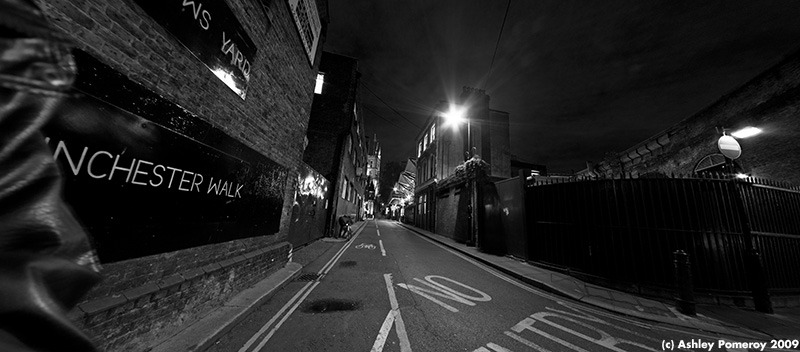 Can you see the strange bendy shape in the extreme left of the image above? That's my jacket. It's surprisingly easy with such a wide field of view to capture parts of yourself - your toes or beer belly at the bottom of the frame, your thumb in the corner, your trousers or arms if you are holding the camera to one side, your horn if you are a unicorn.
Can you see the strange bendy shape in the extreme left of the image above? That's my jacket. It's surprisingly easy with such a wide field of view to capture parts of yourself - your toes or beer belly at the bottom of the frame, your thumb in the corner, your trousers or arms if you are holding the camera to one side, your horn if you are a unicorn. A word about mounts. The lens was designed a long time ago, back when the Soviet Union's standard lens mount was the 42mm screw-thread M42 mount, which was used on cameras made by Zenit and Praktica. My lens is in this mount, and I can use it on my Canon cameras with an M42-EOS adapter. The M42 mount is easy to adapt to other cameras, and I understand that Zenitars for the Olympus OM, Contax/Yashica, Pentax, and Sony/Minolta mounts are actually M42 lenses bundled with the appropriate adapter. The lens is also available with a native Nikon F-Mount, because there is no easy way to adapt M42 lenses so that they work properly on a Nikon camera.
A word about mounts. The lens was designed a long time ago, back when the Soviet Union's standard lens mount was the 42mm screw-thread M42 mount, which was used on cameras made by Zenit and Praktica. My lens is in this mount, and I can use it on my Canon cameras with an M42-EOS adapter. The M42 mount is easy to adapt to other cameras, and I understand that Zenitars for the Olympus OM, Contax/Yashica, Pentax, and Sony/Minolta mounts are actually M42 lenses bundled with the appropriate adapter. The lens is also available with a native Nikon F-Mount, because there is no easy way to adapt M42 lenses so that they work properly on a Nikon camera. It's worth pointing out that the lens is manual everything - manual focus, manual stop-down, with stop-down metering. It's also worth pointing out that when the lens is focused to infinity, and set to f/5.6 and beyond, everything from a couple of meters to the end of the world is in focus, so you just compose and shoot. As a consequence of this the lens is fantastically easy to use, which is for the good because it is hard to compose a fisheye image in such a way that it will look wonderful after being stretched out with software. One problem is that everything appears far away, even if you are standing only a few feet from the action. It is a stand-offish lens that makes people look tiny. You have to get right up close if you want an object to appear in the foreground.
It's worth pointing out that the lens is manual everything - manual focus, manual stop-down, with stop-down metering. It's also worth pointing out that when the lens is focused to infinity, and set to f/5.6 and beyond, everything from a couple of meters to the end of the world is in focus, so you just compose and shoot. As a consequence of this the lens is fantastically easy to use, which is for the good because it is hard to compose a fisheye image in such a way that it will look wonderful after being stretched out with software. One problem is that everything appears far away, even if you are standing only a few feet from the action. It is a stand-offish lens that makes people look tiny. You have to get right up close if you want an object to appear in the foreground. On an optical level the Zenitar is surprisingly good, despite my copy having a lot of dust and other crap inside it. The images are sharp in the centre from f/5.6 onwards and remain sharp to the extreme corners. If it was a "normal" lens it would be an extremely good performer. The only noticeable problem is chromatic aberration, which is pronounced towards the edges of the frame. This can be corrected with software, but not entirely eliminated, and the process of stretching the images tends to emphasise it. There are very few formal tests of fisheye lenses on the internet, but Photozone.de had a look at Canon's 15mm, which seems to be optically very similar to the Zenitar. Perhaps sharpness and chromatic aberration are a general trait of fisheye lenses. The frustrating thing is that Canon's non-fisheye wide and ultra-wide lenses tend to perform poorly in the extreme corners, whereas the fisheye lenses perform very well but are fisheyes. If only Canon could combine the image quality of the latter with the conventional perspective of the former. They would rule the world.
On an optical level the Zenitar is surprisingly good, despite my copy having a lot of dust and other crap inside it. The images are sharp in the centre from f/5.6 onwards and remain sharp to the extreme corners. If it was a "normal" lens it would be an extremely good performer. The only noticeable problem is chromatic aberration, which is pronounced towards the edges of the frame. This can be corrected with software, but not entirely eliminated, and the process of stretching the images tends to emphasise it. There are very few formal tests of fisheye lenses on the internet, but Photozone.de had a look at Canon's 15mm, which seems to be optically very similar to the Zenitar. Perhaps sharpness and chromatic aberration are a general trait of fisheye lenses. The frustrating thing is that Canon's non-fisheye wide and ultra-wide lenses tend to perform poorly in the extreme corners, whereas the fisheye lenses perform very well but are fisheyes. If only Canon could combine the image quality of the latter with the conventional perspective of the former. They would rule the world.One way to combat the chromatic aberration is to manually paint over the colour fringing with a shade that blends in with the background. As this only has to be done to colour transitions towards the edge of the frame it is not too onerous. A second method is to simply crop off the extreme edges, as in the image of the Natural History Museum just up above. The end result is still very wide, but with more consistent image quality across the frame. This has the second benefit of removing the most distorted parts of the image. Which is a good thing.
I have generally used the lens hand-held. The following shot was taken in Westminster Tube Station during a very brief moment when there were no people:
 Since I wrote the original version of this post there have been two interesting developments that have made using a fisheye lens much easier. The first is that most modern digital SLRs have an electronic spirit level, which is important because it is very hard to keep the horizon exactly level when taking a shot with a fisheye. When the image is stretched out, any errors you make when trying to hold the camera level are magnified. You have to rotate the image so that it is level, and crop the result so that it is rectangular again. This eats away many precious pixels that you could otherwise have put to good use.
Since I wrote the original version of this post there have been two interesting developments that have made using a fisheye lens much easier. The first is that most modern digital SLRs have an electronic spirit level, which is important because it is very hard to keep the horizon exactly level when taking a shot with a fisheye. When the image is stretched out, any errors you make when trying to hold the camera level are magnified. You have to rotate the image so that it is level, and crop the result so that it is rectangular again. This eats away many precious pixels that you could otherwise have put to good use.Secondly, modern full-frame digital SLRs tend to have higher usable ISO ratings than earlier models. All of the images on this page bar two were shot with a Canon 5D, which had impressive high ISO image quality back in 2005, but is unexceptional today. The indoors images were taken from ISO 400 upwards. The following image was shot at ISO 3200, at 1/10th, and has been put through so much noise reduction that it looks like a cartoon:
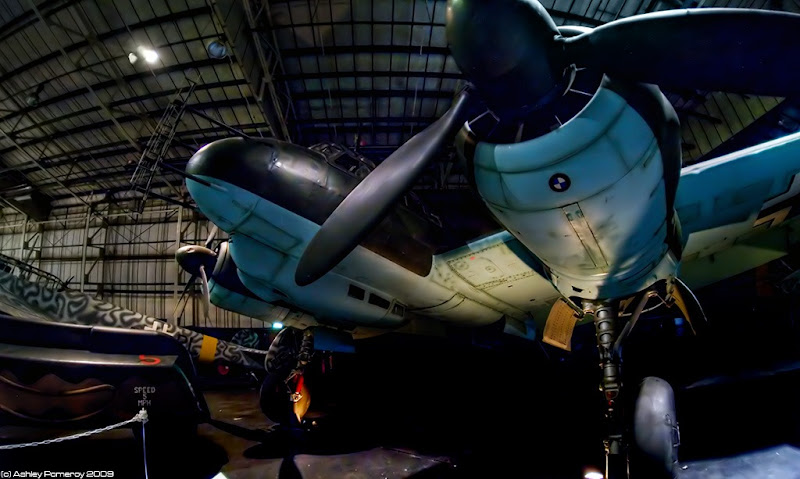 Modern full-frame digital SLRs tend to have less of a problem with ISO 3200 and higher, and would give me a bit more flexibility to shoot hand-held in darkness. I could stop the aperture down a little more or take shots at faster shutter speeds. It has to be said that it is easy to shoot with a fisheye lens at low shutter speeds. The old rule of thumb is that the shutter speed should be at least the same as the focal length of the lens, in which case 1/25th is more than enough for a 16mm fisheye.
Modern full-frame digital SLRs tend to have less of a problem with ISO 3200 and higher, and would give me a bit more flexibility to shoot hand-held in darkness. I could stop the aperture down a little more or take shots at faster shutter speeds. It has to be said that it is easy to shoot with a fisheye lens at low shutter speeds. The old rule of thumb is that the shutter speed should be at least the same as the focal length of the lens, in which case 1/25th is more than enough for a 16mm fisheye.All of the shots on this page have been run through a piece of software called Panotools. It is a free library of image processing plugins that interface with Photoshop, The GIMP, and other image editors, and it can also be run standalone with a front-end called PTGui. In particular I have used PTRemap, which was designed to stretch out fisheye images in order to create panoramas. Originally the software was limited to 8-bit image processing only, which was a bind especially when trying to recover blown highlights, but modern versions can cope with 16-bit RAW files.
The next three images are examples of how a fisheye image can be stretched out. These were taken with a Canon EOS 50 35mm film camera using Kodachrome 64 slide film:
 At the top is the original fisheye image, digitised with a cheap slide duplicator mounted on a Canon 5D. PTRemap allows you to expand the image by a greater or lesser amount. A value of 80° produces the image in the middle, which retains some of the fisheye flavour, whilst a value of 130° produces the image at the bottom, which is almost fully corrected and has an aspect ratio approaching the 2.39:1 of Cinemascope. There are only so many ways to compose an image with such a wide aspect ratio - it is sometimes said that Cinemascope was fine for snakes and people lying down, useless for faces - but then again there are only so many ways to love a woman, or paint a picture, and yet people still love women and people still paint pictures.
At the top is the original fisheye image, digitised with a cheap slide duplicator mounted on a Canon 5D. PTRemap allows you to expand the image by a greater or lesser amount. A value of 80° produces the image in the middle, which retains some of the fisheye flavour, whilst a value of 130° produces the image at the bottom, which is almost fully corrected and has an aspect ratio approaching the 2.39:1 of Cinemascope. There are only so many ways to compose an image with such a wide aspect ratio - it is sometimes said that Cinemascope was fine for snakes and people lying down, useless for faces - but then again there are only so many ways to love a woman, or paint a picture, and yet people still love women and people still paint pictures.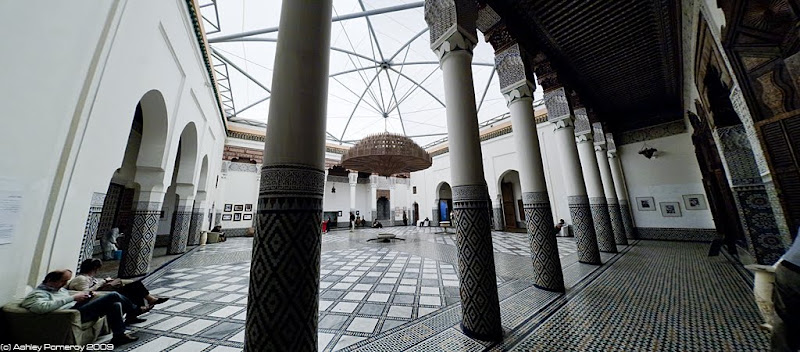 The process of stretching out the image has a negative effect on image sharpness - the central portion of the image tends to remain sharp, but the left and right edges become very blurry. One way to minimise the ugliness is to compose the image so that the edges are dark or indistinct or naturally undetailed areas of flat colour. In the example above the edges are in shadow, and no-one will pay much attention to them. In the example below the giant columns do not have much detail:
The process of stretching out the image has a negative effect on image sharpness - the central portion of the image tends to remain sharp, but the left and right edges become very blurry. One way to minimise the ugliness is to compose the image so that the edges are dark or indistinct or naturally undetailed areas of flat colour. In the example above the edges are in shadow, and no-one will pay much attention to them. In the example below the giant columns do not have much detail: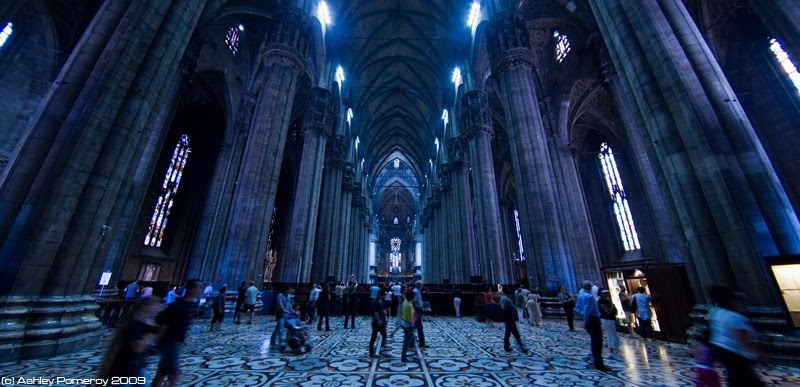 As a wide angle lens, the Zenitar is time-consuming and fiddly, but it is much cheaper than the 14mm wideangle lenses that are offered by most of the major manufacturers, or for that matter Sigma's 12-24mm f4.5/5.6, which is the widest lens available for modern digital SLRs. Judging by this extremely handy field-of-view calculator, a 16mm fisheye lens when mounted on a full-frame or 35mm film camera has a horizontal field of view of 137°. which is roughly the same as a conventional 7mm lens, which does not exist. Even if you crop off the edges, you still have a very wide image. It is wider than the popular Horizon panoramic camera, and a lot less fussy to use.
As a wide angle lens, the Zenitar is time-consuming and fiddly, but it is much cheaper than the 14mm wideangle lenses that are offered by most of the major manufacturers, or for that matter Sigma's 12-24mm f4.5/5.6, which is the widest lens available for modern digital SLRs. Judging by this extremely handy field-of-view calculator, a 16mm fisheye lens when mounted on a full-frame or 35mm film camera has a horizontal field of view of 137°. which is roughly the same as a conventional 7mm lens, which does not exist. Even if you crop off the edges, you still have a very wide image. It is wider than the popular Horizon panoramic camera, and a lot less fussy to use. Put another way, for £130 and a bit of know-how you become the widest kid on the block. You can get back at the bastards that belittled and mocked you and disrespected you, because no matter how prominently they tote around their expensive wide angle lenses, you can go wider. And you don't have to mess around with a tripod and panorama stitching software. You can go wider with your bare hands. The women respect that too.
Put another way, for £130 and a bit of know-how you become the widest kid on the block. You can get back at the bastards that belittled and mocked you and disrespected you, because no matter how prominently they tote around their expensive wide angle lenses, you can go wider. And you don't have to mess around with a tripod and panorama stitching software. You can go wider with your bare hands. The women respect that too.



